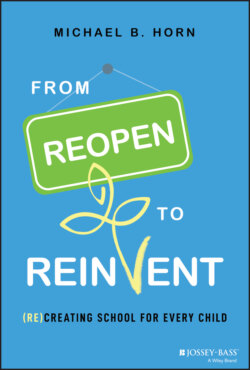Читать книгу From Reopen to Reinvent - Michael B. Horn - Страница 24
THREAT RIGIDITY
ОглавлениеBalancing multiple concerns amid limited resources, restrictive policies, and work contracts that often limit educators' responses helps explain some of the struggles to innovate. Research by Clark Gilbert, previously the president of Brigham Young University Pathway Worldwide and BYU-Idaho, suggests another important set of factors—as well as a pathway forward.
In Gilbert's research, he found that when there was a “discontinuous” change—an abrupt event in the environment—if an organization framed it as a threat, then it was able to marshal far more resources to meet the challenge than if it framed something as an opportunity. That means that saying that the COVID-caused disruption is an opportunity to reinvent schooling is unlikely to gain traction. This echoes the findings of Nobel Prize winners Daniel Kahneman and Amos Tversky that individuals are typically more willing to commit financial resources to something when they perceive it would otherwise result in a loss rather than a gain.
But there's a further insight.
Although framing something as a threat caused an organization to marshal the resources to tackle a challenge, it also caused organizations to respond with something called “routine rigidity,” or “threat rigidity.” When this happens, an organization doubles down on its existing processes or routines. That results in more top-down control; reduced experimentation—at precisely the time that an organization needs to be experimenting a lot, given the new circumstances; and a focus on an organization's existing resources, rather than questioning what else it might use to respond to the threat. When Gilbert studied this in the newspaper industry, he found that organizations that saw the Internet as a threat marshaled resources to invest in the Internet, but “most sites simply reproduced the newspaper” online.3
Sound familiar?
This is, in many ways, what schools did during the pandemic. Amid a flurry of headlines and studies around the learning loss of their students and questions about how schools would deliver learning online or, better yet in most cases, be able to get students back in the classroom, there was no question that schools would see the moment as a threat. Many marshaled resources to meet that threat. Most schools battened down the hatches and just sought to get things running without asking more fundamental questions around what the teaching and learning experiences should look like. They typically replicated the existing assumptions around the classroom, teaching processes, educator roles, the curriculum, content, and so forth—and merely modified them for the circumstance and modality, meaning whether they were online, in person, or in a hybrid format.
In other words, framing the pandemic as a threat has been important to marshal resources. Gilbert's research suggests that framing concerns around learning loss have been important to galvanize the unprecedented levels of federal investment into schools.
But leaving it in that threat framing created an inflexible response that was bound to traditional processes, rather than imagining what schooling could be. This isn't all that different from research that shows that it's difficult for individuals to feel curious while feeling threatened.4
Chapter 4 delves deeper into why a shift away from the initial framing of learning loss is important and what that should look like within schools. But Gilbert's work suggests a more generalizable, structural way to escape threat rigidity.
After defining something as a threat to muster the required resources, it's then important to shift responsibility to a new independent group that can reframe the threat as an opportunity. In this case, that opportunity is to reimagine the schooling experience. As Gilbert noted, having both a threat and opportunity framing was “hard to maintain in an environment in which operating responsibilities for the [existing organization] predominated.”5
Another way to think of it is that if there isn't at least one person in the organization whose full-time job is to focus on the opportunity at hand and innovate, then it's no one's job. That's because the day-to-day priorities of the organization will drain energy away from any efforts to create something new and different. In other words, the urgent and immediate tasks in front of someone—even if they aren't important in the long run—will almost always drown out the important but less urgent work of long-term transformation.6
